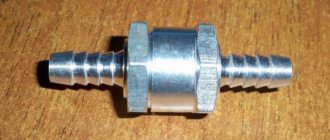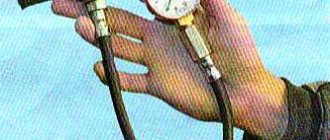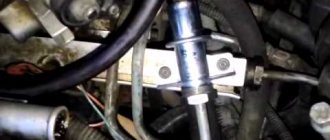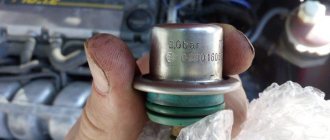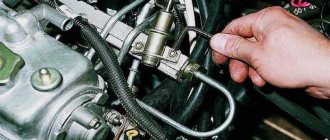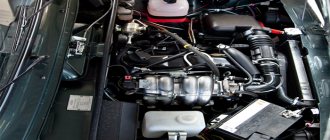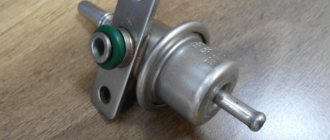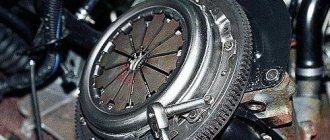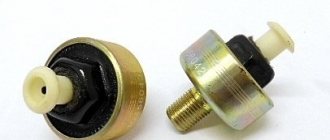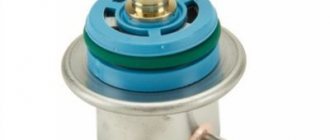The fuel pressure regulator is an element of the injection engine power system, which allows you to maintain the required fuel pressure in the fuel injectors at different operating modes of the internal combustion engine. In other words, the overall performance of the injectors and the stability of the engine depend on the serviceability of the fuel pressure regulator (FPR).
Considering that the pressure regulator is actually a diaphragm valve, failure of this element can greatly affect the operation of the engine. In this article we will look at the principle of operation of the regulator, highlight the main signs of its malfunction, and also talk about how to check the fuel pressure regulator.
Read in this article
Fuel pressure regulator malfunctions
Malfunctions of the fuel pressure regulator lead to the fact that the engine starts with difficulty, has a “floating” idle speed, the car loses dynamic characteristics, and sometimes fuel leaks from the fuel hoses. As a rule, a fuel pressure regulator (abbreviated as RTD) is installed on the fuel rail and is a vacuum valve. In some car models, the RTD cuts into the fuel return hose of the fuel system. To determine that the fuel system malfunction lies in a faulty pressure regulator, it is necessary to carry out a series of simple checks.
How to check an RTD with your own hands. Pro tip
There are several ways you can use to check the condition of the RTD in your garage. The “classic” option, also known as the oldest option, is to disconnect or clamp the bypass valve, while observing the force of the jet pressure. This method was popular when checking pressure on VAZs. Currently it is practically not used.
Today, the simplest and most reliable way to check is to use a pressure gauge.
It is necessary to set the engine to idle speed, then connect a pressure gauge between the fuel hose and the fitting, having first disconnected the vacuum hose. When taking measurements, the pressure in the fuel system should not rise above 0.7 Bar.
Where is the fuel pressure regulator located?
To find the installation location of the fuel pressure regulator, let’s figure out what it is and what it is needed for. This will help in further searches and diagnostics.
The first thing you need to know is that there are two main types of RDTs - mechanical (old type) and electrical (new type). In the first case, this is a vacuum valve, the task of which is to transfer excess fuel under excessive pressure back into the fuel tank through the corresponding hose. In the second, it is a fuel pressure sensor that transmits relevant information to the ECU.
Typically, the fuel pressure regulator is located directly on the fuel rail. Another option for its placement is the fuel return hose of the power system. Another option is to locate the regulator directly in the fuel tank on the pump module. In such systems there is no fuel return hose as unnecessary. Such an implementation has several advantages, including simplified design (no extra pipeline), excess fuel does not enter the engine compartment, fuel heats up less and does not evaporate as much.
How does the fuel pressure regulator work?
Structurally, the old-style valve (installed on gasoline cars) has its own body, inside which there is a valve, a membrane and a spring. The housing has three fuel outlets. Through two of them, gasoline passes through the pressure regulator, and the third outlet is directly connected to the intake manifold. At low (including idle) engine speeds, the fuel pressure in the system is low and it all goes into the engine. As the speed increases, the corresponding pressure increases in the manifold, that is, at the third terminal of the RTD, a vacuum (vacuum) is created, which, at a certain value, overcomes the resistance force of its spring. This creates the movement of the membrane and the opening of the valve. Accordingly, excess fuel gains access to the second outlet of the regulator and goes back into the fuel tank through the return hose. Due to the described algorithm, the fuel pressure regulator is often called a check valve.
As for the fuel pressure sensor, it is a little more complicated. So, it consists of two parts - mechanical and electrical. The first part is a metal membrane that bends under the influence of force caused by pressure in the fuel system. The thickness of the membrane depends on the pressure for which the fuel system is designed. The electrical part of the sensor consists of four strain gauges connected according to a “Winston bridge” circuit. Voltage is applied to them, and the more the membrane bends, the greater the output voltage from them will be. And this signal is sent to the ECU. As a result, the electronic control unit sends the appropriate command to the pump so that it supplies only the amount of fuel required at the moment.
Diesel engines have a slightly different fuel pressure regulator design. In particular, they consist of a solenoid (coil) and a rod, which rests against the ball to shut off the reverse flow. This was done for the reason that the diesel engine vibrates very strongly during its operation, which affects the wear of the classic (gasoline) fuel regulator, that is, partial and even complete compensation of hydraulic vibrations occurs. However, its installation location is similar - in the engine fuel rail. Another option is on the fuel pump housing.
Signs of a malfunctioning fuel pressure regulator
There are five main symptoms of a malfunctioning fuel pressure regulator (both types), which can be used to judge the complete or partial failure of this important unit. Moreover, the symptoms indicated below are typical for cars with both gasoline and diesel engines. However, it is worth mentioning that the listed situations may be signs of failure of other engine components (fuel pump, clogged fuel filter), so it is advisable to carry out comprehensive diagnostics in order to accurately determine its performance. So, the signs of a malfunctioning fuel pressure regulator are as follows:
- Difficulty starting the engine . This is usually expressed in a long rotation of the starter with the accelerator pedal depressed. Moreover, this sign is characteristic under any external weather conditions.
- The engine stalls at idle . To maintain its operation, the driver must constantly apply gas. Another option is that when the engine is idling, the speed is usually “floating”, unstable, until the engine stops completely.
- Loss of power and dynamics . Simply put, the car “does not pull,” especially when driving uphill and/or when loaded. The dynamic characteristics of the car are also lost, it accelerates poorly, that is, when trying to accelerate, a deep drop in revolutions occurs at their high values.
- Fuel is leaking from the fuel hoses (rail) . In this case, replacing hoses (clamps) and other nearby elements does not help.
- Excessive fuel consumption . Its value will depend on both the breakdown factors and the engine power.
Replacement
Replacement process By following the instructions step by step, you can independently remove and install a new fuel pressure regulator without any problems.
- Work on dismantling the device can only be carried out if the engine is cold. If you just drove into the garage, give the car some time to cool down.
- When the engine is running, high pressure remains inside the system, so it must be reduced before work.
- Disconnect the negative terminal from the battery to avoid electric shock and damage to the wiring.
- Remove the vacuum hose.
- Unscrew the nuts on the drain pipe and gradually reduce the fuel pressure level in this way. Be sure to hold the hose fitting with one hand.
- The tube and the washer are connected to each other by a regular rubber ring.
- The screw that holds the clamping bar is unscrewed.
- Now this very bar can be put aside for a while.
- Slightly unscrew the fixing nut that holds the drain tube and the regulator itself.
- Remove the fastening screws of the regulator holding it to the ramp.
- Carefully remove the nut, which will ultimately allow you to remove the object we are looking for.
- Install the new device by following the reverse dismantling sequence.
Checking the fuel pressure regulator
Testing the functionality of the fuel pressure regulator will depend on whether it is mechanical or electrical. the old regulator of a gasoline engine . You need to act according to the following algorithm:
- find the fuel return hose in the engine compartment;
- start the engine and let it run for about one minute, so that it is no longer cold, but also not hot enough;
- using pliers (carefully so as not to damage it) pinch the above fuel return hose;
- If the engine was previously “troubling” and running poorly, but after pinching the hose it started working well, it means that the fuel pressure regulator has failed.
How to determine the performance of an injector
In modern injection gasoline engines, firstly, instead of rubber fuel hoses, metal tubes are installed (due to high fuel pressure and for reliability and durability), and secondly, electrical sensors based on strain gauges are installed.
Accordingly, checking the fuel pressure sensor comes down to checking the output voltage from the sensor when the supplied fuel pressure changes, in other words, increasing/decreasing engine speed. This will make it clear whether the fuel pressure regulator has failed or not.
Another method of checking is with a pressure gauge. So, a pressure gauge is connected between the fuel hose and the fitting. Before doing this, be sure to disconnect the vacuum hose. You also first need to find out what normal fuel pressure should be in the engine (it will be different for carburetor, injection and diesel engines). Typically, for injection engines, the corresponding value is in the range of approximately 2.5...3.0 atmospheres.
Diagnostics
If you notice characteristic signs, you should first make sure that the problem lies in the sensor. To do this you will need to do the following:
- unscrew the fitting plug, which is located on the end of the ramp block and performs the functions of monitoring the fuel pressure;
- there is a special ring at the bottom of the plug that compensates for distances - inspect it carefully;
- if the ring is damaged, has flaws, or has become less elastic, be sure to replace it with a new one;
- then, using the tire cap, unscrew the spool located in the middle of the fitting;
- Using a tire pressure gauge, which is usually used to inflate wheels, measure the pressure when the power unit is operating. Compare the resulting value with the one recommended by the car manufacturer. As a rule, it should not exceed 3.3 units.
Basically, when the vacuum hose of the sensor is disconnected, the pressure begins to increase.
If it remains at the same level, it means that the fuel pressure sensor in the VAZ 2110 ramp is definitely broken and requires replacement.
In the future, it is recommended to regularly inspect the RTD. If, after replacing a part, fuel consumption still remains high, the replacement may have been carried out incorrectly and should be carried out more carefully.
How to troubleshoot the VAZ 2110 fuel pressure regulator?
Replacing the fuel pressure regulator yourself on a car like a VAZ 2110 should not cause any special problems.
Even a beginner can cope with the task, so there is no need to immediately seek help from specialists at a service station and pay them a fairly large sum of money. In addition, not every car service center will do quality repairs.
Causes of fuel regulator malfunction
In fact, there are not many reasons why the fuel pressure regulator has failed. Let's list them in order:
- Natural wear and tear . This is the most common reason for RTD failure. As a rule, this happens when the car's mileage is about 100...200 thousand kilometers. A mechanical malfunction of the fuel pressure regulator results in the membrane losing its elasticity, the valve may jam, and the spring weakens over time.
- Defective parts . This does not happen so often, but often there are defects on products from domestic manufacturers. Therefore, it is advisable to buy original spare parts from imported manufacturers or check them before purchasing (be sure to pay attention to the warranty).
- Poor quality fuel . Unfortunately, domestic gasoline and diesel fuel often contain excessive moisture, as well as debris and harmful chemical elements. Due to moisture, rust spots may appear on the metal elements of the regulator, which spread over time and interfere with its normal operation, for example, the spring weakens.
- Clogged fuel filter . If there is a large amount of debris in the fuel system, it will also lead to clogging of the RTD. Most often, in such cases, the valve begins to jam or the spring wears out.
As a rule, if the fuel pressure regulator is faulty, it is not repaired, but replaced with a new one. However, before throwing it away, in some cases (especially when talking), you can try cleaning the RTD.
Cleaning the fuel regulator
Before replacing it with a new similar element, you can try to clean it, since this procedure is simple and accessible to almost every car owner in a garage. Often, special carburetor cleaners or carb cleaners are used for this (some car enthusiasts use the well-known WD-40 for similar purposes).
The most common (and most accessible) thing is to clean the filter mesh, which is located on the outlet fitting of the fuel pressure regulator. Through it, fuel is supplied directly to the fuel rail. Over time, it becomes clogged (especially if low-quality fuel with mechanical impurities and debris is regularly poured into the car tank), which leads to a decrease in the capacity of both the regulator in particular and the entire fuel system as a whole.
Accordingly, in order to clean it, it is necessary to dismantle the fuel pressure regulator, disassemble it, and use a cleaner to get rid of deposits both on the mesh and inside the regulator body (if possible).
Dirty fuel regulator mesh
After cleaning the mesh and the regulator body, it is advisable to force them to dry using an air compressor before installation. If there is no compressor, place them in a well-ventilated, warm room for a time sufficient to completely evaporate moisture from their external and internal surfaces.
Another exotic cleaning option is the use of an ultrasonic unit at a car service center. In particular, they are used for high-quality cleaning of injectors. Ultrasound can be used to “wash” small, stubborn dirt. However, here it is worth weighing the cost of the cleaning procedure and the price of a new mesh or fuel pressure regulator as a whole.
Pressure regulator VAZ 21083, 21093, 21099, injector
The pressure regulator is an element of the fuel supply system (power system) of the injection engine of VAZ 21083, 21093, 21099 cars. The pressure regulator is designed to regulate the amount of fuel pressure in the power system and maintain it within specified limits, ensuring the correct functioning of the injection system at different engine operating modes.
Fuel rail pressure regulator VAZ 21083, 21093, 21099 injector
— Location on the engine
In the fuel systems of VAZ 21083, 21093, 21099 vehicles, the fuel pressure regulator is installed on the engine fuel rail, to the left in the direction of travel of the vehicle.
— Fuel pressure regulator device
The fuel pressure regulator VAZ 21083, 21093, 21099 is a membrane-type valve that opens when the fuel pressure increases and passes it through the drain line back into the gas tank. The regulator is attached to the ramp with two bolts (5 mm hexagon). The connection between the regulator and the ramp is sealed with a rubber ring. A vacuum supply hose is placed on top of the pressure regulator fitting, and a return line drain pipe is attached to the bottom using a 24 mm nut.
A membrane (diaphragm) is installed inside the pressure regulator, dividing its cavity into two isolated parts (one with fuel, connected to the ramp, the other is supplied with vacuum from under the throttle valve). The membrane is connected to a valve, which unlocks or, conversely, closes the outlet to the drain line. On the opposite side, the membrane is supported by a return spring.
Fuel pressure regulator device for VAZ 21083, 21093, 21099 cars with an injection engine
— Operating principle of the pressure regulator
The pressure regulator maintains fuel pressure in the fuel rail within 2.8 - 3.2 bar. This pressure is necessary for the injectors to work properly. If the fuel pressure exceeds the specified limits, the membrane moves inside the regulator body, overcoming the resistance of the return spring and opening the shut-off valve connected to it. The fuel is discharged through the valve into the return line. The pressure drops, the membrane moves the valve back, stopping the fuel drain.
In addition, the operation of the regulator is affected by the opening or closing of the throttle valve and, accordingly, an increase or decrease in the load on the engine. As the load increases, more pressure is required in the fuel rail, and as the load decreases, less pressure is required. To do this, vacuum is supplied to the space behind the regulator membrane from the engine receiver. If it is present or absent, the membrane, acting on the valve, closes or opens the fuel discharge.
When the throttle valve is closed (for example, idling), the vacuum in the engine intake manifold is high and the diaphragm is pulled back, opening the valve. The fuel is discharged, the pressure in the fuel rail drops.
After pressing the gas pedal, the vacuum behind the throttle valve drops and, accordingly, this drop is transmitted through the hose to the behind-the-diaphragm space of the regulator. The diaphragm (membrane) moves forward under the action of a spring, acts on the valve and it closes the fuel discharge. The pressure in the fuel rail increases, which improves the efficiency of the injectors.
— Malfunction of the pressure regulator
The main malfunction of the fuel pressure regulator is the diaphragm getting stuck in a certain position due to loss of mobility. Depending on the position in which the diaphragm is stuck, the pressure in the fuel rail will either not be there at all, or it will be increased. To identify a malfunction, check the pressure regulator. A faulty regulator should be replaced.
— Applicability of the pressure regulator in the fuel systems of VAZ 21083, 21093, 21099 cars
VAZ 21083, 21093, 21099 cars: ECM with GM ISFI-2S control unit – pressure regulator 2112-1160010-01 (manufactured by GM). With January blocks, BOSH, VS – pressure regulator 2112-1160010 (domestic production).
Diagnostics
The serviceability of the fuel pressure regulator is checked by measuring the pressure in the fuel rail. Let's consider the algorithm for checking the pressure regulator using the example of a VAZ-2110 car with an injection power system. This car uses an injector with fuel recirculation, so the RTD is located on the fuel rail. To do this, you will need a pressure gauge, as well as a piece of oil-resistant rubber tube and two clamps. The algorithm of actions is as follows:
- We produce fuel from the ramp (we remove the fuse responsible for powering the electric fuel pump, start the engine and wait for it to stop voluntarily).
- On the ramp we find a fitting designed to relieve pressure and remove the cap on it.
- We unscrew the spool valve from the fitting (carefully and slowly, since fuel may remain in the ramp).
- We pull the tube onto the fitting and secure it with a clamp.
- We connect a pressure gauge to the tube and also fix it.
- We put the fuse back and start the engine.
- We install it on the XX motor.
- We check the pressure gauge readings (on the VAZ-2110 this parameter is 2.8-3.2 Atm.).
- We find the pipe coming from the manifold on the regulator and disconnect it from the RTD. If the device is working properly, this action will lead to an increase in pressure by 0.3-0.7 Atm.
Inconsistencies in pressure gauge readings will indicate a problem with the regulator or other system components. To accurately identify the cause of the malfunction, you need to diagnose the operation of other components.
